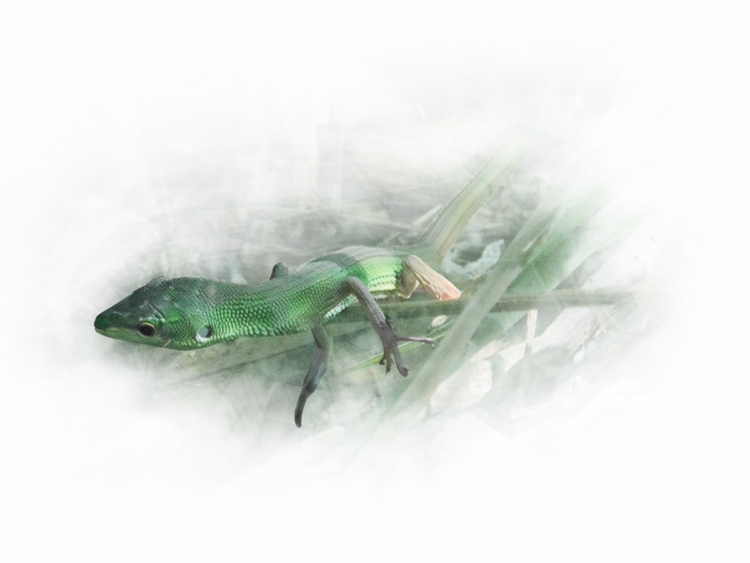
Takydromus toyamai (Takeda & Ota, 1996)
クジャクが天敵?宮古島固有のトカゲ
Peacock Threat to a Miyako Island Lizard
全長はオスで約29cm、メスで約27cm。尾は全長の約4分の3を占めるほど長く、ヘビのように細長い体型のトカゲです。宮古諸島にのみ生息する固有種で、1996年に新種として記載されました。
現地では古くから知られていましたが、新種としての登録が遅れたのには理由があります。以前はアオカナヘビと同種と考えられていましたが、DNA解析の結果、異なる祖先から進化した別種であることが判明したのです。アオカナヘビはトカラ列島や奄美諸島、沖縄島に分布し、腹部の鱗列数が8列であるのに対し、ミヤコカナヘビは6列です。また、アオカナヘビの体側には白い線が入るなど、形態にも違いが見られます。
日本には6種のカナヘビが知られていますが、その中でもミヤコカナヘビは特に希少で、環境省のレッドデータブックでは絶滅危惧IA類に指定されています。かつては民家近くの草むらなどで普通に見られましたが、2000年代に入ると個体数が急減しました。生息地の減少や農薬・除草剤の使用、さらに外来種であるニホンイタチやインドクジャクによる捕食が主な原因と考えられています。こうした状況を受け、2018年には爬虫類として初めて国の保護増殖事業の対象種に指定され、保全活動が進められています。宮古島では捕食者であるインドクジャクの防除が行われ、全国の水族館や動物園では飼育・繁殖の取り組みも続けられています。
ミヤコカナヘビはライフサイクルが短く、年に2世代が回ることもあるほど早熟で短命です。日本に広く分布するニホンカナヘビの寿命が3〜4年ほどであるのに対し、ミヤコカナヘビの寿命は1年に満たないとされます。近年の研究では、繁殖が温度に強く影響されることが明らかになっており、30℃を超えると産卵数が増える一方で、23℃以下では産卵がほとんど停止することがわかっています。
he male Miyako grass lizard reaches about 29 cm in total length, while the female measures about 27 cm. Its tail accounts for roughly three quarters of its body length, giving it a slender, snake-like appearance. This species is endemic to the Miyako Islands of Okinawa Prefecture and was formally described as a new species in 1996.
Although well known locally, its recognition as a distinct species came late. For a long time it was thought to be the same as the Okinawa tree lizard (Takydromus smaragdinus), but DNA analysis revealed that it had evolved from a different ancestral lineage. The Okinawa tree lizard is distributed in the Tokara Islands, the Amami Islands, and Okinawa Island. It differs from the Miyako grass lizard in having eight rows of belly scales instead of six, and a distinct white stripe along its sides.
Japan is home to six species of grass lizards, but the Miyako grass lizard is among the rarest. It is listed as Critically Endangered (IA) in the Red Data Book of the Ministry of the Environment. Once commonly seen in grassy areas near houses, its population began to decline rapidly after the 2000s. The main causes are thought to include habitat loss, the use of agricultural chemicals and herbicides, and predation by introduced species such as the Japanese weasel (Mustela itatsi) and the Indian peafowl (Pavo cristatus). In response to this crisis, the species became the first reptile designated under Japan’s National Breeding and Propagation Program in 2018. Conservation efforts are now underway, including control of invasive peafowl on Miyako Island and captive breeding programs at aquariums and zoos throughout Japan.
The Miyako grass lizard has a short life cycle, sometimes producing two generations in a single year. While the common Japanese grass lizard (Takydromus tachydromoides) lives about three to four years, the Miyako grass lizard rarely lives for more than a year. Recent research has shown that its reproduction is strongly influenced by temperature: egg production increases at temperatures above 30 °C, but almost ceases when temperatures fall below 23 °C.
参考文献
環境省 | 自然環境・生物多様性 | ミヤコカナヘビ 2025年11月1日閲覧
RIB Lab. 琉球 島嶼生物地理学 研究室 | ミヤコカナヘビのページ 2025年11月1日閲覧
琉球大学 | 研究成果 | 宮古諸島固有の絶滅危惧種ミヤコカナヘビの生活史特性~年に2世代が回ることもある早熟で短命なトカゲ~ | (2024年7月29日) 2025年11月1日閲覧
エコアイランド通信 | ミヤコカナヘビの保全活動の実態と私たちにできること | (2024年10月16日) 2025年11月1日閲覧
WWFジャパン | 世界で沖縄県の宮古諸島だけに生息する希少種ミヤコカナヘビの保全 | (2024年9月20日) 2025年11月1日閲覧
エコロギー | カナヘビの長生きに 必要な飼育習慣とは? |初心者でもできる環境づくり | (2025年7月4日) 2025年11月1日閲覧